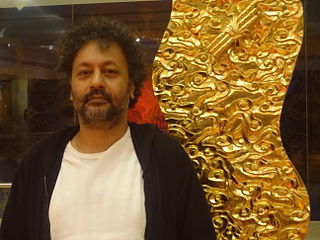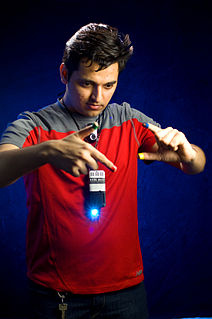 W
WGesture recognition is a topic in computer science and language technology with the goal of interpreting human gestures via mathematical algorithms. Gestures can originate from any bodily motion or state but commonly originate from the face or hand. Current focuses in the field include emotion recognition from face and hand gesture recognition. Users can use simple gestures to control or interact with devices without physically touching them. Many approaches have been made using cameras and computer vision algorithms to interpret sign language. However, the identification and recognition of posture, gait, proxemics, and human behaviors is also the subject of gesture recognition techniques. Gesture recognition can be seen as a way for computers to begin to understand human body language, thus building a richer bridge between machines and humans than primitive text user interfaces or even GUIs, which still limit the majority of input to keyboard and mouse and interact naturally without any mechanical devices. Using the concept of gesture recognition, it is possible to point a finger at this point will move accordingly. This could make conventional input on devices such and even redundant.
 W
WASIMO is a humanoid robot created by Honda in 2000. It is currently displayed in the Miraikan museum in Tokyo, Japan. On July 8, 2018, Honda posted the last update of Asimo through their official page stating that it would be ceasing all development and production of Asimo robots in order to focus on more practical applications using the technology developed through Asimo’s lifespan. The name was chosen in honor of Isaac Asimov.
 W
WThe AudioCubes are a collection of wireless intelligent light emitting objects, capable of detecting each other's location and orientation, and user gestures, and were created by Bert Schiettecatte. They are an electronic musical instrument used by electronic musicians for live performance, sound design, music composition, and creating interactive applications in max/msp, pd and C++. The AudioCubes are an example of a Tangible User Interface as well as an ambient device.
 W
WThe EyeToy is a color webcam for use with the PlayStation 2. Supported games use computer vision and gesture recognition to process images taken by the EyeToy. This allows players to interact with the games using motion, color detection, and also sound, through its built-in microphone. It was released in October 2003.
 W
WIn the field of gesture recognition and image processing, finger tracking is a high-resolution technique developed in 1969 that is employed to know the consecutive position of the fingers of the user and hence represent objects in 3D. In addition to that, the finger tracking technique is used as a tool of the computer, acting as an external device in our computer, similar to a keyboard and a mouse.
 W
WGesture Description Language is a method of describing and automatic (computer) syntactic classification of gestures and movements created by doctor Tomasz Hachaj (PhD) and professor Marek R. Ogiela(PhD, DSc). GDL uses context-free formal grammar named GDLs. With GDLs it is possible to define rules that describe set of gestures. Those rules play similar role as rules in classic expert systems. With rules it is possible to define static body positions and sequences of key frames that create together definitions of gestures or movements. The recognition is done by forward chaining inference engine. The latest GDL implementations utilize Microsoft Kinect controller and enable real time classification. The license for GDL-based software allows using those programs for educational and scientific purposes for free.
 W
WMicrosoft HoloLens 2 is a pair of mixed reality smartglasses developed and manufactured by Microsoft. It is the successor to the pioneering Microsoft HoloLens. On February 24, 2019 the HoloLens 2 enterprise edition debuted as the first variant of the device, followed by a developer edition that was announced on May 2, 2019. It was subsequently released in limited numbers on November 7, 2019.
 W
WToshio Iwai is a Japanese interactive media and installation artist who has also created a number of commercial video games. In addition he has worked in television, music performance, museum design and digital musical instrument design.
 W
WKinect is a line of motion sensing input devices produced by Microsoft and first released in 2010. The technology includes a set of hardware originally developed by PrimeSense, incorporating RGB cameras, infrared projectors and detectors that mapped depth through either structured light or time of flight calculations, and a microphone array, along with software and artificial intelligence from Microsoft to allow the device to perform real-time gesture recognition, speech recognition and body skeletal detection for up to four people, among other capabilities. This enables Kinect to be used as a hands-free natural user interface device to interact with a computer system. Kinect is a peripheral that sits atop the user's display similar to a webcam.
 W
WLeap Motion, Inc. was an American company that manufactured and marketed a computer hardware sensor device that supports hand and finger motions as input, analogous to a mouse, but requires no hand contact or touching. In 2016, the company released new software designed for hand tracking in virtual reality. The company was sold to its British rival Ultrahaptics in 2019, which sells the Leap Motion product under the brand name Ultraleap.
 W
WLM3LABS is a start-up company that develops hardware and software for motion-based control of computers.
 W
WRanjit Makkuni is an international multimedia artist and designer, the honorary director of the design think tank, the Sacred World Research Laboratory, as well as a musician, sitar player, and songwriter.
 W
WMicrosoft HoloLens, known under development as Project Baraboo, are a pair of mixed reality smartglasses developed and manufactured by Microsoft. HoloLens was the first head-mounted display running the Windows Mixed Reality platform under the Windows 10 computer operating system. The tracking technology used in HoloLens can trace its lineage to Kinect, an add-on for Microsoft's Xbox game console that was introduced in 2010.
 W
WPranav Mistry is a computer scientist and inventor. He is the President and CEO of STAR Labs since October 2019. He is best known for his work on SixthSense, Samsung Galaxy Gear and Project Beyond.
 W
WObject detection is a computer technology related to computer vision and image processing that deals with detecting instances of semantic objects of a certain class in digital images and videos. Well-researched domains of object detection include face detection and pedestrian detection. Object detection has applications in many areas of computer vision, including image retrieval and video surveillance.
 W
WOmek Interactive was a venture-backed technology company developing advanced motion sensing software for human-computer interaction. Omek was co-founded in 2007 by Janine Kutliroff and Gershom Kutliroff.
 W
WOpenCV is a library of programming functions mainly aimed at real-time computer vision. Originally developed by Intel, it was later supported by Willow Garage then Itseez. The library is cross-platform and free for use under the open-source Apache 2 License. Starting with 2011, OpenCV features GPU acceleration for real-time operations.
 W
WThe PlayStation Eye is a digital camera device, similar to a webcam, for the PlayStation 3. The technology uses computer vision and gesture recognition to process images taken by the camera. This allows players to interact with games using motion and color detection as well as sound through its built-in microphone array. It is the successor to the EyeToy for the PlayStation 2, which was released in 2003.
 W
WThe Power Glove is a controller accessory for the Nintendo Entertainment System. The Power Glove gained public attention due to its early virtual reality mechanics and significant marketing. However, its two games did not sell well, as it was not packaged with a game, and it was criticized for its imprecise and difficult-to-use controls.
 W
WRainbows End is a 2006 science fiction novel by Vernor Vinge. It was awarded the 2007 Hugo Award for Best Novel. The book is set in San Diego, California, in 2025, in a variation of the fictional world Vinge explored in his 2002 Hugo-winning novella "Fast Times at Fairmont High" and 2004's "Synthetic Serendipity". Vinge has tentative plans for a sequel, picking up some of the loose threads left at the end of the novel. The many technological advances depicted in the novel suggest that the world is undergoing ever-increasing change, following the technological singularity, a recurring subject in Vinge's fiction and nonfiction writing.
 W
WSixthSense is a gesture-based wearable computer system developed at MIT Media Lab by Steve Mann in 1994 and 1997, and 1998, and further developed by Pranav Mistry, in 2009, both of whom developed both hardware and software for both headworn and neckworn versions of it. It comprises a headworn or neck-worn pendant that contains both a data projector and camera. Headworn versions were built at MIT Media Lab in 1997 that combined cameras and illumination systems for interactive photographic art, and also included gesture recognition.
 W
WSnapdragon is a suite of system on a chip (SoC) semiconductor products for mobile devices designed and marketed by Qualcomm Technologies Inc. The Snapdragon central processing unit (CPU) uses the ARM RISC. A single SoC may include multiple CPU cores, an Adreno graphics processing unit (GPU), a Snapdragon wireless modem, a Hexagon digital signal processor (DSP), a Qualcomm Spectra image signal processor (ISP) and other software and hardware to support a smartphone's global positioning system (GPS), camera, video, audio, gesture recognition and AI acceleration. As such, Qualcomm often refers to the Snapdragon as a "mobile platform". Snapdragon semiconductors are embedded in devices of various systems, including Android, Windows Phone and netbooks. They are also used in cars, wearable devices and other devices. In addition to the processors, the Snapdragon line includes modems, wi-fi chips and mobile charging products.
 W
WTelepointer is a neck-worn gestural interface system developed by MIT Media Lab student Steve Mann in 1998. Mann originally referred to the device as "Synthetic Synesthesia of the Sixth Sense". In the 1990s and early 2000s Mann used this project as a teaching example at the University of Toronto.
 W
WUmoove is a high tech startup company that has developed and patented a software-only face and eye tracking technology. The idea was first conceived as an attempt to aid people with disabilities but has since evolved. The only compatibility qualification for tablet computers and smartphones to run Umoove software is a front-facing camera. Umoove headquarters are in Israel on Jerusalem’s Har Hotzvim.
 W
WA wired glove is an input device for human–computer interaction worn like a glove.